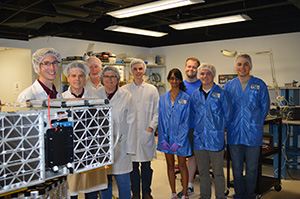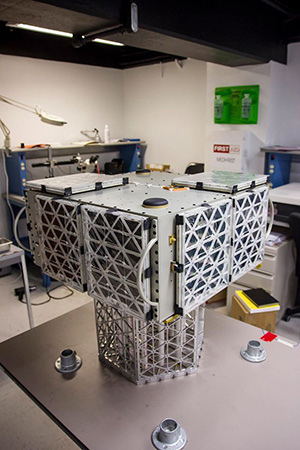 Safely packed in a custom foam box on board the Cygnus spacecraft for the OA-4 International Space Station cargo resupply mission, the AggieSat4 (AGS4), a satellite constructed by students from Texas A&M University’s AggieSat Laboratory,lifted off on December 6 to the International Space Station (ISS) with the Bevo-2 cubsat tucked safely inside. OA-4 launched from Space Launch Complex 41 at the Cape Canaveral Air Force Station in Florida.
Safely packed in a custom foam box on board the Cygnus spacecraft for the OA-4 International Space Station cargo resupply mission, the AggieSat4 (AGS4), a satellite constructed by students from Texas A&M University’s AggieSat Laboratory,lifted off on December 6 to the International Space Station (ISS) with the Bevo-2 cubsat tucked safely inside. OA-4 launched from Space Launch Complex 41 at the Cape Canaveral Air Force Station in Florida.
Once aboard the ISS, it will be stowed by the crew until the tentative deployment date of Feb. 22. Prior to deployment, the satellite will be attached to the NASA JSC Space Station Integrated Kinetic Launcher for Orbital Payload Systems (SSIKLOPS) ejection system, developed for use on the JEM-EF robotic arm. The satellite will be launched from the Japanese airlock into outer space where, once in an independent orbital trajectory, Bevo-2, a satellite constructed by students from The University of Texas at Austin, will be released from AGS4. The two satellites will then interact with each other, transmitting information to a ground station at Texas A&M’s Riverside campus.
 The constructing of AGS4, a 50-kilogram satellite, was started in 2010 as the second mission of the Low Earth Orbiting Navigation Experiment for Spacecraft Testing Autonomous Rendezvous and Docking (LoneStar) campaign. Sponsored by the Aeroscience and Flight Mechanics Division (AFMD) at Johnson Space Center (JSC), Lonestar is a multi-year multi-mission collaborative program between Texas A&M’s AggieSat Lab and The University of Texas, with the purpose of developing autonomous rendezvous and docking (ARD) technologies.
The constructing of AGS4, a 50-kilogram satellite, was started in 2010 as the second mission of the Low Earth Orbiting Navigation Experiment for Spacecraft Testing Autonomous Rendezvous and Docking (LoneStar) campaign. Sponsored by the Aeroscience and Flight Mechanics Division (AFMD) at Johnson Space Center (JSC), Lonestar is a multi-year multi-mission collaborative program between Texas A&M’s AggieSat Lab and The University of Texas, with the purpose of developing autonomous rendezvous and docking (ARD) technologies.
ARD will be utilized in future exploration programs for unmanned cargo vehicles and in assembly of future space structures. Data from LONESTAR will have a direct impact on the development of that capability. For successful travel beyond low Earth orbit to the moon, Mars and beyond, the ability for two spacecraft to autonomously rendezvous and dock in space must be demonstrated. The use of small satellites such as AGS4 for research has become very popular because of tighter federal budgets and the availability of launch vehicles to transport them into space. Multiple satellites can be placed on one rocket and delivered into orbit. This allows new technologies to be tested without putting them on larger, much more expensive spacecraft.
“We’re using these small satellites to demonstrate that they can go up, they can maneuver around each other, they can dock and undock and they can pass information back and forth and with the ground,” said Dr. Helen Reed, director of the AggieSat Lab and professor in the Department of Aerospace Engineering at Texas A&M.
 LONESTAR is a low-cost, low-risk project designed to prove that ARD procedures can be performed successfully in space, and it provides NASA with actual flight data that is directly linked to the Space Technology Roadmap TA05 Communication and Navigation: Position, Navigation and Timing. It will provide invaluable flight data for the global positioning system (GPS) receiver, designed strictly for space applications, to demonstrate precision relative navigation and precision real-time navigation, as well as orbit determination.
LONESTAR is a low-cost, low-risk project designed to prove that ARD procedures can be performed successfully in space, and it provides NASA with actual flight data that is directly linked to the Space Technology Roadmap TA05 Communication and Navigation: Position, Navigation and Timing. It will provide invaluable flight data for the global positioning system (GPS) receiver, designed strictly for space applications, to demonstrate precision relative navigation and precision real-time navigation, as well as orbit determination.
 After Bevo-2 is released from AGS4, the two satellites will track and videotape each other, passing information back and forth to calculate where they are. The focus of the experiment is to demonstrate three-axis attitude determination and control (within two degrees), collect DRAGON carrier phase GPS data, capture video of Bevo-2 release, compute and crosslink relative navigation solutions and track Bevo-2. Texas A&M students will be tracking and collecting this information at the Riverside ground station. The experiment will test the detachment and cross-linked communication protocols between the two satellites and the ground stations. Additionally, the flight serves as a technology demonstration platform for the relative navigation positioning and attitude control and translation systems.
After Bevo-2 is released from AGS4, the two satellites will track and videotape each other, passing information back and forth to calculate where they are. The focus of the experiment is to demonstrate three-axis attitude determination and control (within two degrees), collect DRAGON carrier phase GPS data, capture video of Bevo-2 release, compute and crosslink relative navigation solutions and track Bevo-2. Texas A&M students will be tracking and collecting this information at the Riverside ground station. The experiment will test the detachment and cross-linked communication protocols between the two satellites and the ground stations. Additionally, the flight serves as a technology demonstration platform for the relative navigation positioning and attitude control and translation systems.
“There will be some long nights where we’re out there as the satellite passes overhead collecting data down from our satellite,” said Reed.
The AGS4 project is entirely student staffed and run, with daily oversight from Reed, who serves as the primary contact with NASA. Graduate students lead, manage and participate in all decisions and activities, while a mix of undergraduate and graduate students from freshmen to Ph.D. candidates makes up the complete team.
“We invite anybody on campus who has an interest in space to join us, independent of what their major is,” said Reed. “They don’t have to be engineers. The only requirement is that they be U.S. Residents, per federal law.”
A small satellite, from concept to launch, can be done in the order of three to four years, so it fits very neatly into the average student’s timeline while they are at the university.
Each incremental stage in the LONESTAR project benefits NASA by increasing the agency’s knowledge of a currently emerging field where rapid development and cost-effective projects are a major focus. For future projects, they will take the technologies they have demonstrated in the past projects and build on their complexities for the next satellite to send into orbit. The goal of getting small satellites to mate with larger objects in space opens all sorts of possibilities, among them: on-orbit servicing of dead satellites in space, objects coming together to make larger habitats in space, as well as affixing to a piece of space junk and de-orbiting it out of harms’ way.
“Doing things autonomously with small missions is going to be especially important as we venture as humans out into the solar system and do these same kinds of tasks: building larger structures, building habitats, collecting information, transmitting it back to Earth, things like this,” said Reed. “These small satellites are really going to be game changers in our space mission.”
About AggieSat Lab
AggieSat Lab, founded by Dr. Helen Reed, is a student satellite program housed within the Department of Aerospace Engineering at Texas A&M University. The goal of the lab is to develop and demonstrate modern technologies by using a small satellite platform, while educating students and enriching the undergraduate experience. The lab takes an integrated approach to small spacecraft research, design-build-fly and education for multidisciplinary teams of freshmen through graduate students, along with industry and government affiliates. Students are responsible for the design process from concept to end-of-mission. Students simultaneously pursue degrees and participate in a business environment with real-world deliverables, quality-assurance checks, documentation, design and safety reviews, and organization. The goal is for students to gain hands-on mastery in current tools, systems engineering, and industry practices related to specification, design, analysis, fabrication and testing of space vehicle systems, while actively applying and extending complementary concepts taught in classes and making critical decisions. The context for this program is in advancing small real satellites, yet the skill set learned is applicable to a wide variety of disciplines and industries.